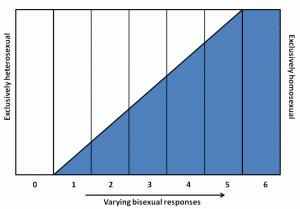
I’m sitting at a lover’s home in Denton writing this instead of at the Dallas LGBTQ pride festival like I planned, because my Fibromyalgia is acting up after a weekend of too much fun and not very much sleep. I rode up to Denton with a gay male friend of my (female) lover. He’s a very sweet guy, so what follows is not meant to attack his character in any way, but make a point about bisexual invisibility and just how deeply pervasive it can be in our culture — even in people who are very supportive of gayness, bisexuality, and queerness.
What is bisexual invisibility? Well, it’s the tendency to assume people fall into one of two halves of a strict dichotomy: that they are straight or they are gay. This is not so different from our tendency to assume all people fall into other overly simplistic dichotomies, like black and white or male and female. When you see a man on a date with a woman, or exhibiting characteristics that our culture has associated with heterosexuality, it’s easy to assume they are straight. The opposite is true if you see him with a man — well then he must be gay. Even though it’s been over 60 years since the publication of the Kinsey Scale, this attitude is still widely pervasive especially (but certainly not exclusively) when it comes to men.
So what did this guy know about me? As we began our ride from Austin to Denton, he knew that a) I was going to visit a woman and that b) I was planning to attend the Pride Festival. On the ride up, we discussed many queer friendly topics such as Madonna, Lady Gaga, and Ke$ha (including an aside by me on a cute hippie boy in the video for “Your Love is my Drug”), fashion, and Austin’s queer community. Upon arrival in Denton, my lover made comments about how her roommate would be the only straight man present this weekend, and that my new gay friend would be the only one around who didn’t like women (we were joined later in the weekend by two lesbian friends).
Then moments later, a commercial for a new TV show appeared on Logo, which we were watching. My ride to Denton commented on the hotness of the lead actor, to which I responded with a dismissive ‘meh.’ He was just much too clean cut for me, as I tend to prefer freaky guys for the most part. But my ride said, “Well, Kit, of course you feel that way because you are straight.” Despite what seemed like it should be overwhelming evidence to the contrary, my bisexuality had still been ignored as a reflex. For the record, I consider myself a Kinsey 2 — interested in a broader spectrum of the female population than the male, but with a very genuine love for cock.
Some of this behavior stems from our culture’s biphobia, or even a denial of the existence of true bisexuals. As we waited in line to go dancing at Sue Ellen’s, a lesbian club in Dallas’s gayborhood frequented by people of all orientations who want to dance, a pair of women stood on the rooftop lounge loudly proclaiming their guesses for the orientation of each person who passed them by in the crowd below. A woman behind us gave them the middle finger when they proclaimed her bisexual, angrily retorting that they’d know her love for pussy if they saw her up close.
And yet much of this behavior is far less conscious. I know because I can see it in myself. Later that night, while dancing to Sue Ellen’s DJ Alex, I caught myself guessing the orientation of the people around me, though I didn’t vocalize it. These people were obviously gay, those women dancing together obviously lesbian, and that male-female couple, well, clearly straight people here to dance — ironic thoughts coming from this queer, whose female lover was not far away.
What can we do about this? Try to raise awareness in our own minds and in those of others. Try to separate the sexual acts people perform from the definition of who they are. And, I think, we should encourage the use of umbrella terms like ‘queer,’ which reflect the true fluidity of human sexual behavior. If you’re in the Dallas area, the DFW BiNet group is doing an excellent job at this; I’ll be back in Austin and unable to attend, but this Thursday they are holding a Mixer for all bisexual people and their allies.
In addition to being thought-provoking, this visit has been a lot of other things too. It’s been a wonderfully good time. It’s felt liberating to be surrounded by queer people and spend the weekend thinking and talking about queer topics — not to mention laughing, loving, and partying with so many beautiful queer people. I’m sorry to have missed the parade and festival, but very glad I came.
More recently in this blog: Coming Out